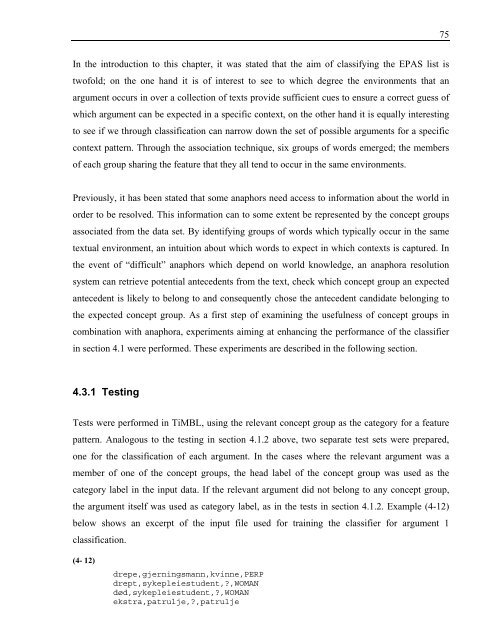Unni Cathrine Eiken February 2005
Unni Cathrine Eiken February 2005
Unni Cathrine Eiken February 2005
You also want an ePaper? Increase the reach of your titles
YUMPU automatically turns print PDFs into web optimized ePapers that Google loves.
In the introduction to this chapter, it was stated that the aim of classifying the EPAS list is<br />
twofold; on the one hand it is of interest to see to which degree the environments that an<br />
argument occurs in over a collection of texts provide sufficient cues to ensure a correct guess of<br />
which argument can be expected in a specific context, on the other hand it is equally interesting<br />
to see if we through classification can narrow down the set of possible arguments for a specific<br />
context pattern. Through the association technique, six groups of words emerged; the members<br />
of each group sharing the feature that they all tend to occur in the same environments.<br />
Previously, it has been stated that some anaphors need access to information about the world in<br />
order to be resolved. This information can to some extent be represented by the concept groups<br />
associated from the data set. By identifying groups of words which typically occur in the same<br />
textual environment, an intuition about which words to expect in which contexts is captured. In<br />
the event of “difficult” anaphors which depend on world knowledge, an anaphora resolution<br />
system can retrieve potential antecedents from the text, check which concept group an expected<br />
antecedent is likely to belong to and consequently chose the antecedent candidate belonging to<br />
the expected concept group. As a first step of examining the usefulness of concept groups in<br />
combination with anaphora, experiments aiming at enhancing the performance of the classifier<br />
in section 4.1 were performed. These experiments are described in the following section.<br />
4.3.1 Testing<br />
Tests were performed in TiMBL, using the relevant concept group as the category for a feature<br />
pattern. Analogous to the testing in section 4.1.2 above, two separate test sets were prepared,<br />
one for the classification of each argument. In the cases where the relevant argument was a<br />
member of one of the concept groups, the head label of the concept group was used as the<br />
category label in the input data. If the relevant argument did not belong to any concept group,<br />
the argument itself was used as category label, as in the tests in section 4.1.2. Example (4-12)<br />
below shows an excerpt of the input file used for training the classifier for argument 1<br />
classification.<br />
(4- 12)<br />
drepe,gjerningsmann,kvinne,PERP<br />
drept,sykepleiestudent,?,WOMAN<br />
død,sykepleiestudent,?,WOMAN<br />
ekstra,patrulje,?,patrulje<br />
75

















